Georgetown, Guyana, is one of the world’s smallest capital cities, a mere six mi.2 according to its official boundaries. The Dutch laid out this city, perched on the northern Atlantic coast of South America, in the 18th century; the British expanded it in the 19th and 20th centuries. Tree-lined avenues, flowing canals, and stunning colonial gardens earned it a reputation as the “Garden City”. Today, it is home to over 285 species of birds—47.5 species per square mile. The Botanic Gardens, a small area (about 75 acres) within the city, has an astonishing 196 species, which are listed here.
Does this density of species make Georgetown the bird capital of the world? It certainly means that anybody with their eyes and ears open could be in for a glorious day of birding.
On the street where I live, a pair of macaws sometimes comes with the dawn, screaming and screeching, vivid blue, with flashes of gold like the sun god, Apollo, in his chariot. The blue-and-yellow macaw is impossible to ignore and is a joy to behold.
The pair often settles down in the branches of a coconut tree across the street and croon gently to each other. Into the sound gap arrives the true dawn chorus, a glorious medley of song and whistling, including the haunting melody of the Pale-breasted Thrushes. They have been recorded here on Youtube.
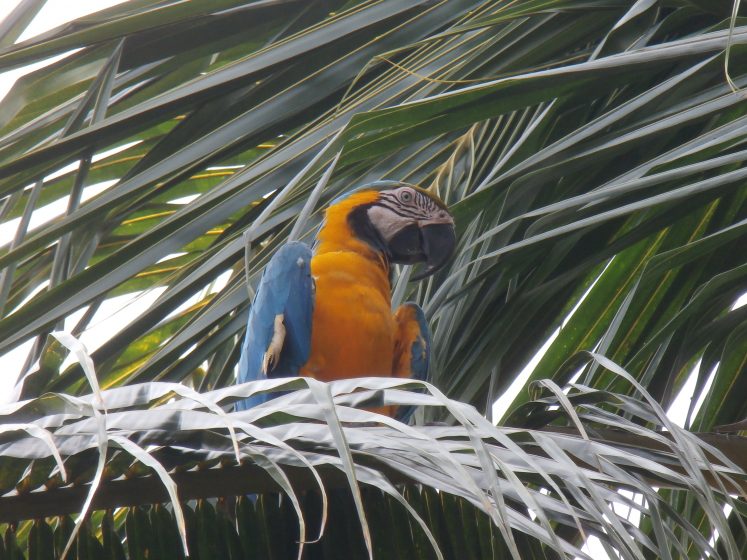
The thrushes have taught me a fraction of their melody and, for a few minutes, we go back and forth, my childishly simple notes embarrassing in contrast to their trills. Several pairs of these Pale-breasted Thrushes have built their nests between the wooden beams and the columns that hold up my house.
I seem to be inadvertently running a baby Thrush factory. The nests are in constant use, except when repairs are necessary. The mother and father are marvellous models of good parenting, flitting back and forth with food, taking it in turns to sit on the nest and remaining ever-alert to danger. From dive-bombing me the first time I picked up one of their fallen babies and put it on a branch out of reach of predators, they have learned to trust me as an ally. On the day that the fledglings are due to leave the nest, the parents keep up a racket until we lock up our dogs. I have observed that on these days, the songbirds congregate in the trees. It seems they, too, are watching out for threats to these precious babies. Perhaps this is an interesting example of interspecies cooperation which contradicts the dominant ideology that life is all about competition and selfishness.

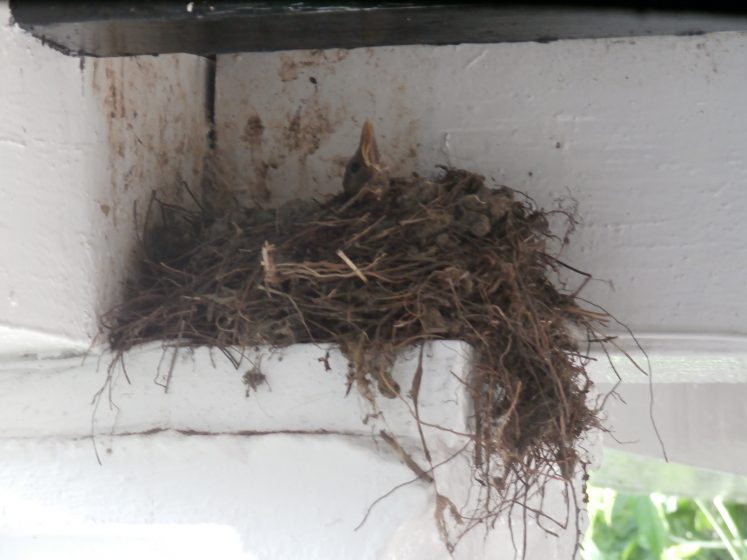
A few weeks ago, the Thrushes’ full volume alarm call brought me rushing into the garden, which was full of highly agitated birds hopping from branch to ground, from fence to flowerpots, and all over the garden. Disaster! One baby Thrush had taken off too soon. Flat on the ground, nose to beak with the baby, was one of our large watchdogs. I grabbed the baby, dropped him in a large flower pot for safety, and put our beloved dog in a fenced-off section. Fifteen minutes later, the birds’ alarm call brought me hurtling back out. There they were again, nose to beak, gazing at each other, the fledgling having launched himself straight back at the watchdog. I have often wondered why the dog did not simply open his jaws and swallow what would have been a tasty morsel.
The dawn chorus marks the time to put out the food. The wire feeders so highly recommended in temperate zones are useless—the birds will not go near them. They prefer two-bird tables made from old tree branches and, best of all, the top of the gate-post, which presumably gives them a better view of predators.
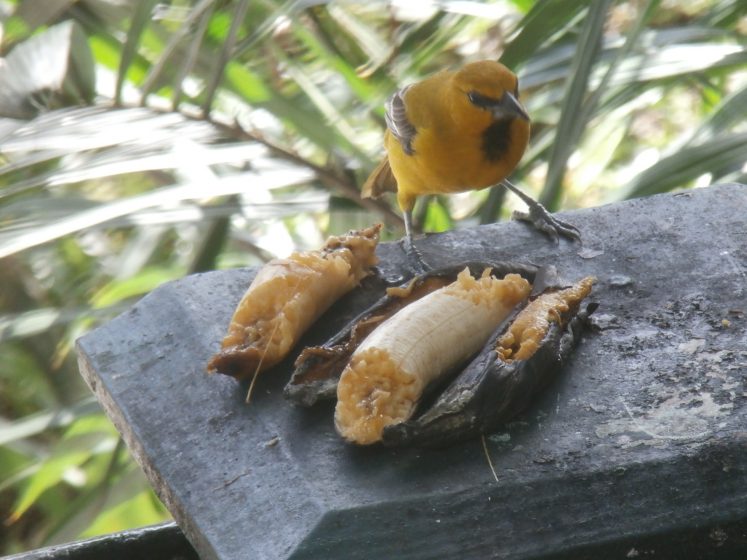
After much experimenting with bird seed and various fruits, I have found that my visitors’ favourite foods are over-ripe papaw and rotting yellow plantains. I am fortunate. There is a stall holder in Bourda, one of the local markets, who gives me yellow plantains for the birds and a fruit vendor who will help out now and then with fruit. The birds on the bird table feel less like visitors and more like residents. Some of them roost in the trees in the garden. Every day there are Yellow Orioles, Grayish Saltators, Blue-grey Tanagers, Palm Tanagers, and the lovely Silver-beaked Tanager. This tanager is very dark—almost black—but when the sun catches him, his throat feathers are a rusty red. The beak is matte silver—more paint than polish—and very striking.
The early morning is popular with people taking exercise and, more importantly to my mind, it is an ideal time to see birds. Thirty seconds’ walk from my house, a pair of Ringed Kingfishers catch fish in the main canal that flows through the city. They perch high on the telephone wires and are easy to miss unless you know to look out for them. They are large for kingfishers and have a distinctive rufous belly and ring around the neck. Truly handsome birds, but not musical, as they take off with their harsh, “Tchak-tchack” cry.
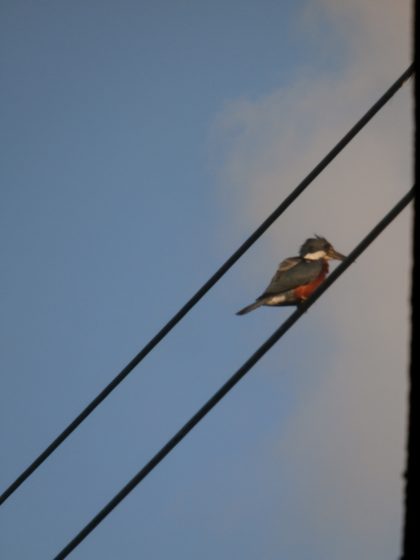
The kites are also in evidence, searching the water for the snails that make up the staple item in their diet. They are visible during the day, but are most active in the morning and late afternoon.
Around the smaller ditches, you can also see Striated Herons, Little Blue Herons, and Snowy Egret catching fish. Occasionally, I have seen a Limpkin completely still at the water’s edge, its unmistakeable beak ready for snails. The egrets seem to be almost as common in the city as in the countryside, mainly because of a large colony in the Botanic Gardens. Sometimes, a Snowy Egret nestling falls out into the water below and is immediately snapped up by a small caiman. The breeding plumage of the snowy egret is stunning and was once worth more than gold.
By mid-morning, doves, woodcreepers, shrikes, flycatchers, finches, and a host of other little birds have been and gone. Once, and only once, a Black-crowned Night-Heron, came into my garden. He sat in a Flamboyant Tree for a few hours completely still and silent before going home to the Botanic Gardens. The hummingbirds ignore my humble offerings, heading straight for the hibiscus nectar. Later come the Great Kiskadees—noisy, boisterous, raucous birds who seem to eat almost anything, including flying insects and small frogs, and who have no qualms about raiding the dogs’ bowls. Great Kiskadees are fearless. It is not unusual to see them mobbing a Yellow-headed Caracara, tormenting one of those powerful raptors until it takes refuge in a tall tree, screaming magnificently. What is very unusual is to see a juvenile and an adult caracara together; I was lucky to see these two from my living room window.

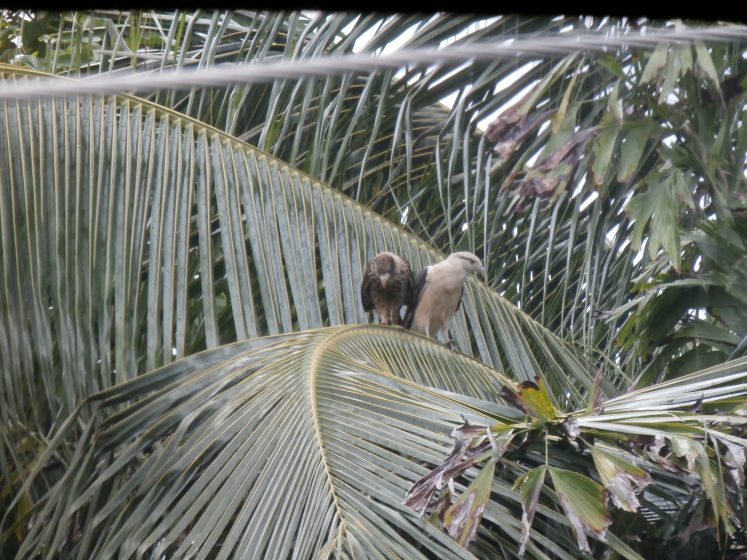
In the hot afternoon, the birds are scarce except for the ever-present thrushes raiding the compost heap for my precious earthworms, and the odd straggler coming in for water at the birdbath. By teatime, the air is still and heavy. The contented tap-tap-tap of the Lineated Woodpecker breaks the monotony. Sitting on the back step with my tea, I can admire this handsome visitor with his bright eyes and scarlet crest and feel privileged that, today, he has chosen my trees for his attention.
Late afternoon reveals tiny birds high up in the sky. These are the swifts and from where I stand on the road outside the house, I am too hopeless a birder to be able to tell which species they belong to. It is much easier to identify the magnificent frigate birds slowly ascending the thermals and heading out over the Atlantic. As the short dusk begins, the Scarlet Ibises fly over, also heading for the ocean. Night sets in. The Barn Owl, ghostly white as the light catches his feathers, gives a piercing screech before disappearing into the gloom. On the best nights of all, a solemn, drawn out “hoo” tells me the Great Horned Owl has come into my garden for a visit.
To live with wild birds is an immeasurable joy. One never knows for sure who is going to visit. Will the Red-shouldered Macaws come in this afternoon? Where are the Orange-winged Parrots? What a delight that the Blue-black Grassquit has suddenly chosen my fence from which to jump up and down, calling for a mate.

But even as I write this rich avian narrative, bird life is being threatened by a combination of ignorance, greed, and deliberate destruction of the city. Georgetown’s magnificent trees, home to so many birds, are slowly disappearing, choked to death with bird vine, or left jagged and damaged by “tree-trimming” exercises authorised by the Mayor and City Council.
Georgetown businesses have knocked down trees and poured concrete over the grass verges to extend their premises or obtain parking. Even private gardens are being turned into concrete so that people can park the vast numbers of secondhand cars imported into Guyana.
Our “Garden City” is being replaced with vertical horrors of mirrored glass. The American Bird Conservancy estimates that up to a billion birds die each year in the USA as a result of glass collisions. Yet, the private sector and the public authorities in Georgetown see nothing wrong with knocking down graceful, colonial wooden buildings that can accommodate birdlife, and replacing them with lethal glass buildings aping New York and Miami. Even the new Catholic church has horrible, mirrored windows which are a potential death trap for the city’s birds. A national “development” strategy focussed on economic growth, rather than on quality of life, has resulted in the Guyanese people adopting a frantic consumer lifestyle. Despite the recent heroic efforts of the government to clean up the city, people continue to throw junk food boxes and other garbage into the canals and ditches, choking the outlets and creating stagnant breeding grounds for mosquitos. The inevitable chemical spraying is harmful to wildlife and leaves me and everybody in our house choking from the fumes. The black night, lit by the stars of the ever-changing sky, has disappeared. Blazing security lights make sections of the city as bright as day. It is impossible to get a normal night’s sleep, and nocturnal birds are going away. The city appears to be sleepwalking towards a lifeless existence.
Georgetown’s residents have to act now. Do we not have a responsibility to ensure that the next generation can experience the wonder of nature?
My neighbour, my gardener, and I replant trees on the streets as a small act of resistance against the dead hand of “development”. Others can choose their own paths of resistance. The Guyana Amazon Tropical Birds Society has, for over a decade, been inspiring at-risk youth with a love for birds by creating checklists, carrying out research, and training their members to identify and care for birds. With appropriate funding, they could convert hearts and minds for birds and provide the technical advice to make Georgetown a bird friendly city once more. The public authorities have to work with us to re-create a city that is elegant, beautiful, and a joy to live in—to restore the Garden City and to keep alive what we like to call the capital city of the bird world.
Melinda Janki
Georgetown

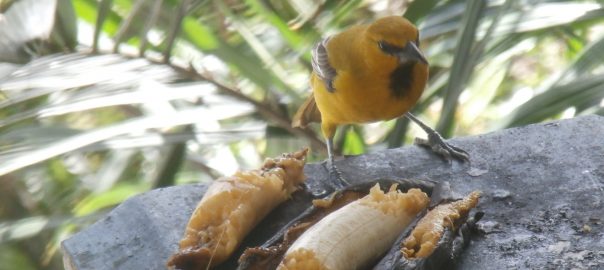







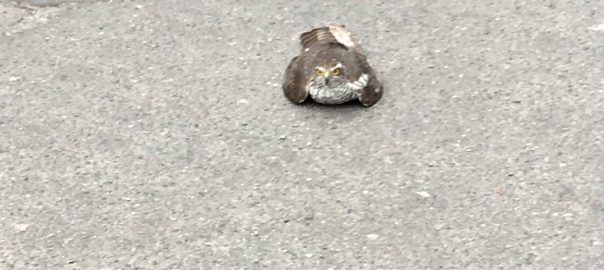
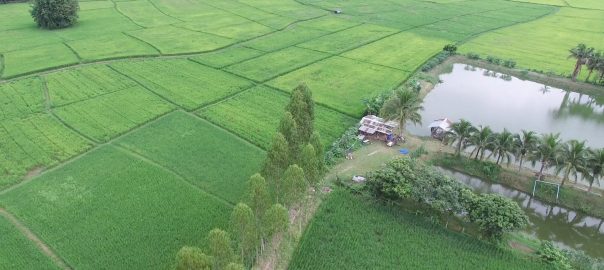
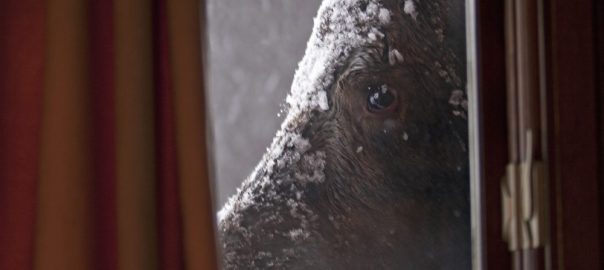
Shoot, just realizing that the email address provided earlier was erroneous.
Please use [email protected] for correspondance.
Apologies
Another P.S. re a link provided in your article: the latest FB post of the GATBS dates from Mar 2019.
Hi again Melinda,
I have very happily birded in GT during a few days during our visit to Guyana, and was astounded by the richness and diversity of city birdlife. Quite heartening that it is still true 8 years after your article 🙂 !
I have birded just 5 dawns in South Ruimvelt, Botanical Gardens, National Park and the coastline mudlflats East of town. My GT list exceeds 60 spp! The only species you mentioned that seemed to have gone are the woodpecker, saltator and B&Y macaw.
The frenetic use of plastic is frightening — despite the article I read saying there was goinf to be a total plastic ban in 2021!!!!!
We are leaving GT tomorrow, but he you wish to further correspond, it would be a pleasure.
P.S. The link to the eBird list for the Botanical Gardens quite oddly appear in French ! ? Is this a bug ? I would appreciate the English version…
Hi Melinda, I’ve just arrived in Georgetown with my family, and researching birding around town, so your article was much welcome and appreciated!
It looks however that there is no birding outings or club active here that people like me could join to discover local birdlife. If you have any suggestion or tips on how to meet local ornithologists and share leisure birding that would be excellent.
Just to clarify, I am not on on birding trip here, just family travel but I can’t help carry binoculars around my neck and wish to be able to name the various species I see here.
Thanks in advance, best
Beautiful birds indeed! I need assistance to establish a name for a bird watching magazine for a project. pls leave your suggestions in my inbox Ty.
Thank you so much Malieka. It’s great to see this post is still being read. I hope that Georgetown residents will protect the city’s beauty and wildlife before it’s all gone.
Thanks for sharing this lovely post about Georgetown. How amazing to have so many species of birds and I love the photo of the blue and yellow macaw and the birdsong recording. What a great initiative to introduce the at-risk youths to the birds and nature as this helps to reduce anti-social behaviour. You are blessed to live in such a place. However, I share your concern about recent developments like the expansion of the urban footprint and concreting over. Planning should guide the owners of private premises to refrain from paving and concerting over green space for parking as this reduces the earth’s porosity and increases localised flooding. Worse this destroys valuable biodiversity and ecosystems that we all depend on. Keep up the amazing work and please provide links for blog posts.
Hello Melinda i really admire wide interest you have. thanks for that beautiful article and photos of the birds I am enjoying seeing them including their nesting. Thanks…
Thank you Ronella. It has been very encouraging to see how many of the diaspora have read this piece. I hope you will come home soon and connect again with our urban avifauna.
This is my second read as I was feeling a bit homesick. Sorry, I failed to say thank you when I first read it (hiding my face). The wonderful thing about Guyana is that you can enjoy a kaleidoscope of flora and fauna almost anywhere you go and this article captures some intricacies we often take for granted. So thank you for bringing a little of home to me. All the best!
Melinda, I thoroughly enjoyed reading your beautiful and passionate article which so clearly describes our birds in Georgetown. Everytime I visit Georgetown, I look forward to the daily ritual of the macaws and parrots screaming and screeching as they fly over our house. Their yellow underbellies really do flash like gold in the sunlight, an unforgettable experience. These and the wide variety of birds sighted daily do need to be protected. I hope Guyanese realise how lucky they are to have this amazing birdlife in their capital city and take positive action to protect them.
Melinda. Congratulations on your excellent article. I was transported back in time to a golden era in Guyana. Continue your Good Work in caring for God`s creatures and the Environment.
Hi Melinda. Great article on the exotic birds in Georgetown and I really enjoyed reading it. It’s ironic that when we are young that these beautiful birds are taken for granted and largely ignored but as we get older our appreciation for them improves. Am envious of the diversity of birds to your home,It makes our own ‘twitching’ look very mundane but we still do our best to enjoy our ‘visitors’ to the feeder. I do hope that your article will focus people’s attention on this issue. Keep up the good work!
Thank you Nigel. I had to look up flaneur. You raised a very important point about identity. We are none of us just one thing. But we are under constant pressure to be ‘homo oeconomicus’ a selfish one-dimensional creature who is alienated from nature and sees everything as a commodity. Schirrmacher did a brilliant critique of this creature in ‘Ego: the game of life.’ We also see commodification in attempts to use the market to put a price on the living world while conveniently forgetting that it was market failure which often caused the destruction of the natural world in the first place. (Climate change being the biggest market failure the world has known according to Nick Stern). However the more that urban dwellers connect with the nature, the happier they are and the more willing to conserve non-human life. This is a really interesting study: http://journals.plos.org/plosone/article?id=10.1371/journal.pone.0149777
Thank you. London is a great city, partly because of its magnificent royal parks that have somehow resisted commodification and continue to provide beauty and peace to millions. Daniel Raven-Ellison has been doing tremendous work on the #NationalParkCity and I hope it does happen. Georgetown too could be a national park city given the high level of biodiversity but it would require a much more creative and imaginative approach than is currently being followed. The ideas shared and the dialogue that takes place on sites like TNOC are really invaluable.
You describe a city I would love to live in, Melinda. As a resident of Birmingham in the United Kingdom, I understand the importance of trees and the green environment in making the concrete jungle liveable for all species including our own. Every good wish for success in your determination to protect what really matters – life!
Very interesting read.
Brava, Melinda!
Your essay has reminded us that it IS possible for humans to live in cities without driving out our fellow living creatures! I have visited Georgetown many times over the past twenty years and I fully endorse your views of the ‘immense joy’ to be gained from living surrounded by such rich life – trees, plants, birds, butterflies and even the odd anaconda! As you and many others on this web site have noted it is essential that man learns to live in harmony with this natural abundance even – or perhaps especially – in cities. More than half of the world’s population now live in an urban setting. In my own country – the United Kingdom – more than 70% of people live in cities. We have seen the damage caused to lives – especially young lives – if we make those cities lifeless concrete jungles. Such cities are literally soul destroying. Georgetown is a shining proof that this does not need to be so. And you are part of a bigger movement. I am sure that your readers will be aware of the push to make London (people population: 8.7 million people – tree population: 8.3 million trees) a National Park City . London is also one of the C40 Group of the world’s biggest cities working to create greener cities. Perhaps Georgetown could lead the way in forming a ‘C40 plus’ group from the global south to show how to preserve their natural heritage. Keep up the great work.
Beautiful Meilinda.
Dear Melinda, an absolutely brilliant piece of writing. You are a novelist not a lawyer! You are a bird watching flaneur, Georgetown critic and prose stylist all rolled in one. I would hear and see birds but your level of of observation and analysis places an entirely different perspective on the term “bird’s eye view.” Congrats, I have to re-read this constantly….it makes one imagine a new Guyana. Saved on my bookmarks.
A well-written and informative article about Guyana’s birds. The government and citizens do indeed have a sacred responsibility to preserve its wildlife. May the “Garden City” be restored to its former beauty!
Thank you Melinda for such a wonderful and informative article on Guyanas’ birds. It was such a delight to read!
Congratulations and look forward to many more.
Well done Melinda!! It was a pleasure reading your informative article and viewing the colorful photographs.
Congratulations! Melinda !!! I am not in the least bit surprised that you continue to surprise us with your accomplishments.
Thank you David, Ryan, Edith and Karly for your kind comments. I have hope in the young! I have learned from enthusiastic birders decades younger than me.
What a wonderful story Melinda. Thank you.
Thank you for this wonderful article. I had no idea Georgetown was so rich in biodiversity.
It is a pleasure to wake to birdsong.
Thank you for sharing this lovely story of the beautiful birds of Guyana. I hope they will be around for many more generations to appreciate.
This is a great read! Thanks! And I loved the photo of the yellow oriole.
Thank you. I would be happy to write a piece for Catholic Standard. The Catholic community has a very important role in protecting nature.
Thank you for this article on the beauty of Guyana. I wish you can make contact with Catholic Standard and write something for it too.